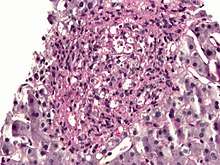PAS diastase stain
Periodic acid–Schiff–diastase (PAS-D, PAS diastase) stain is a periodic acid–Schiff (PAS) stain used in combination with diastase, an enzyme that breaks down glycogen. PAS-D is a stain often used by pathologists as an ancillary study in making a histologic diagnosis on paraffin-embedded tissue specimens. PAS stain typically gives a magenta color in the presence of glycogen. When PAS and diastase are used together, a light pink color replaces the deep magenta. Differences in the intensities of the two stains (PAS and PAS-D) can be attributed to different glycogen concentrations and can be used to semiquantify glycogen in samples. In practice, the tissue is deparaffinized, the diastase incubates, and then the PAS stain is applied.

An example of PAS-D in use is in showing gastric/duodenal metaplasia in duodenal adenomas.[1]
Additional images
 Histoplasma. PAS diastase stain.
Histoplasma. PAS diastase stain. Histoplasma in a granuloma. PAS diastase stain.
Histoplasma in a granuloma. PAS diastase stain.
See also
- Periodic acid-Schiff stain
- Diastase
References
- Rubio CA (2007). "Gastric duodenal metaplasia in duodenal adenomas". J. Clin. Pathol. 60 (6): 661–3. doi:10.1136/jcp.2006.039388. PMC 1955048. PMID 16837629.